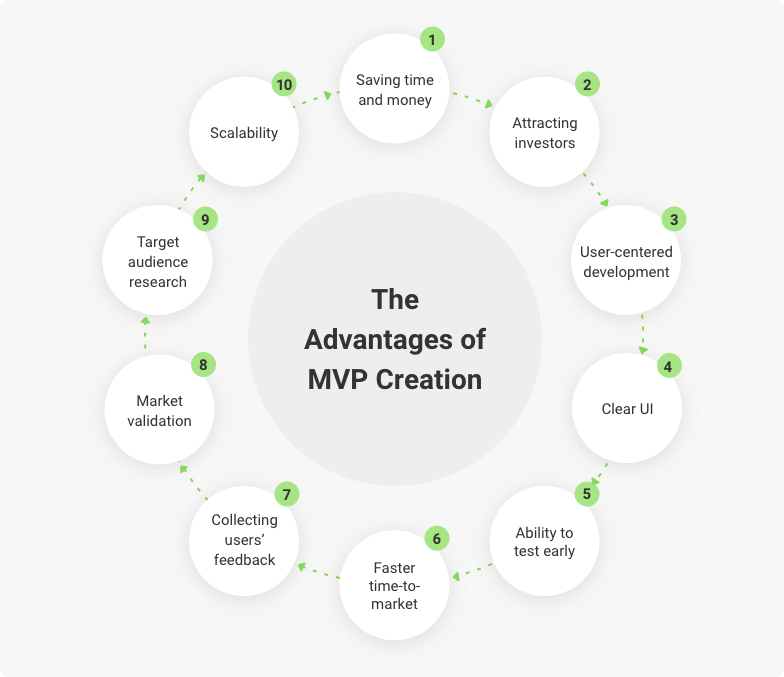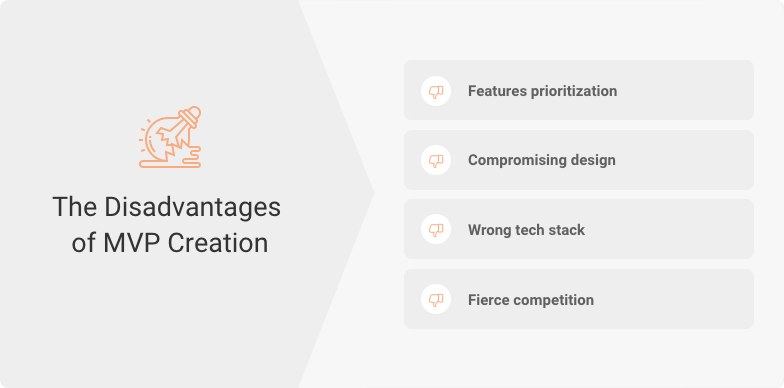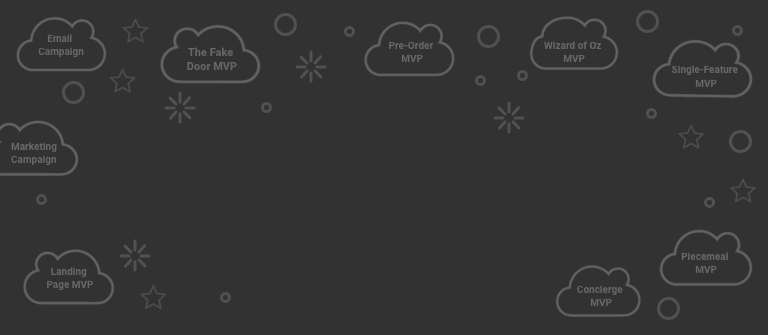Today, people are very picky. They want apps that work perfectly and solve their specific problems easily and fast. On the other hand, product owners struggle to provide a smooth customer experience and get their investments paid back through smart product monetization.
Today's app development is costly, and people in business seek approaches to minimize risks of failure and lost funds. Releasing a minimum viable product version before developing an app with extended functions is one of the most efficient ways to succeed with this goal. Check the key MVP benefits and pitfalls to make the right decision for your product development.
Defining the Minimum Viable Product
In the context of software development, a minimum viable product is a basic app version with a minimum set of features to satisfy a particular customer problem. An MVP is usually created to test app ideas and validate their viability on the actual market. The feedback from the target audience helps to understand if the product is worth further development and what changes should be made for perfection.
The purpose of creating an MVP is to assess how the market will react to a business idea. If users like the product, it makes sense to develop it further. If the launch is unsuccessful, then the business idea has failed, and there’s no sense in wasting money on its development. — Andrey Onoprienko, CTO, KeyUA
Numerous leading software products have proved the effectiveness of MVP creation. Spotify, Amazon, Twitter, Groupon, Airbnb, and many other products began their way on the market from MVP.
To get a more in-depth understanding of the MVP concept, please read our dedicated post What is a Minimum Viable Product?.
The Advantages of Minimum Viable Product
When an entrepreneur launches their startup, they can only guess how consumers will perceive a product. It is all based on the assumption that customers have a specific need, and the future product will solve it in a way that users like.
To find out for sure, a product owner launches an MVP. There are multiple direct and indirect benefits of building an MVP that you should know.

Top 10 Benefits of MVP Development
1. Saving Time and Money
The creation of a full-featured software application takes a long time and requires a big budget. Depending on the complexity, a project may take years and hundreds of thousands of dollars. An MVP version can be launched to the market much faster without making a big financial commitment.
For example, creating a minimum viable product may take from 3 weeks to 3 months. By focusing on building only basic functions, you are spending your money wisely, avoiding budget overruns.
2. Attracting Investors
If you need to attract investors to your organization, there is no better way than using an MVP to demonstrate the product benefits and customer interest. With its help, you can ensure the validity of your business idea before going to investors. It is much easier to attract third-party funds having a solid business idea with proven market demand.
An MVP is a functioning product that investors can see in action. Since investors are overloaded with requests for funds, a minimum viable product improves their chances of investing in your product. An MVP should be accompanied by a business plan and marketing strategy to maximize investment interest.
3. User-Centered Development
The “minimum” nature of the product implies keeping a clear focus on the end-user needs. You limit the features to only those that solve customers’ problems, putting all unnecessary or accessory add-ons aside. While various perks might make your app look sophisticated, they won’t add much value to your product at the early stages. Users prefer clear solutions to their problems as a top priority. And an MVP puts the focus solely on delivering what they need.
Further development iterations are focused on feedback from real users. Starting with the MVP, you can adopt necessary improvements more quickly. Making changes to an MVP requires fewer resources than reworking a big, complex final solution.
4. Clear UI
Have you ever been in a situation when you cannot find the necessary desktop or mobile app option? There are so many buttons, screens, and content that your eyes cannot focus on what you need to find. It is a big problem for modern apps. Developers always want to put as many features as possible, but that overloads the user interface and makes it uncomfortable to follow and use.
With an MVP, you create a product with minimum elements that won’t mislead users. Comparing two apps for the same purpose, users will prefer the one that provides the shortest path to the desired result. In this aspect, some MVPs can beat bigger and maturer competitors.
5. Ability to Test Early
Testing business ideas or UI approaches puts at risk the entire app. In the case of an MVP, it is much easier to test such things, as you haven’t spent too much time and money on its development process, so potential losses are diminished. You can check your hypothesis and make the required improvements before releasing the final product version.
Going to the market implies high risks of being unaccepted by customers. If something like this happens with a fully-featured product, you risk losing all money and efforts spent on development. If an MVP fails, you’re losing less.
6. Faster Time-to-Market
The less time a product needs for development, the faster it gets to market and starts winning customers. One of the most significant benefits of minimum viable products is attracting more money for further development. Therefore, a quick start means faster earnings. You don’t need to work on the product for years before your efforts start to pay off.
If you are developing a topical product that is interesting, delays with the release can cause significant losses. For instance, a pandemic caused a massive demand for online delivery and healthcare services, and it was critical to enter the market as soon as possible. An MVP is an excellent way for a quick start.
7. Collecting Users’ Feedback
There are no more valuable insights for further improvements than the ones brought by real users. MVP gives the ability to gather users’ feedback in the early stages to help focus continued development on users’ needs. You can hear your customers and build the product exactly the way they want instead of guessing their needs.
Even by releasing an MVP without actual development like a piecemeal or pre-order MVP, you can gather lots of insights for building the future product. The sooner you connect with your actual customers, the more effective development you get.
8. Market Validation
An MVP helps to validate the market demand for your specific solution more precisely than any marketing research. The research can define the need for particular features and services and detect interested users. Still, it cannot predict how the market will perceive your specific implementation of the chosen features, while an MVP can.
After an MVP launch, a company can analyze which customer groups are the most active users. Based on this, it is easier to set the right priorities for further development. In case of failure, a startup won’t suffer substantial financial losses. It will have a chance to recover after making necessary changes to the product.
9. Target Audience Research
Similar to market validation, an MVP gives an in-depth understanding of your target audience. Sometimes the product becomes popular among user categories that were not initially considered as a target audience. Only user interaction with an actual product reveals all potential types of consumers.
After defining who your MVP users are, you can learn your target audience's habits and needs. Continuous product success, in the long run, depends mainly on how well you know your customers.
10. Scalability
Another benefit of MVP is better scalability of development. After releasing an MVP and getting real feedback, you can clearly see what changes are needed and what new features should be developed next. In such a gradual build-up approach, the risk of reworking something is lower, and you can focus on advancements.
Based on the feedback from early adopters, the developers can polish the features proposed by an MVP and further iterate by adding functionalities for new use cases. You can scale the product to a broader audience through a steady stream of improvements based on the experience of previous customers.
All these benefits, in one way or another, help optimize the MVP development cost and get valuable insights for creating a product that perfectly fits consumers’ expectations. It is what all startups prioritize.
Drawbacks of MVP
There are specific challenges that accompany the multiple pros of a minimum viable product approach. Keep the following cons in mind when building your MVP.

The Drawbacks of MVP Development
1. Features Prioritization
Defining the “minimum” is not so easy. It’s hard to determine the core features without adding any extras while developing an MVP. It helps if you are very targeted and tactical regarding what you want to get. Your product mission needs to be correctly defined at the start.
It would be wiser to deliver something valid yet straightforward for customers instead of spending resources on unnecessary perks. However, too small a scope may not represent the product value correctly. A team needs to clearly see what customer problem they’re going to solve and what minimum functionality is required to achieve it.
2. Compromising Design
Making an MVP look attractive means a lot of work on the product design. Many startups decide to compensate for the limited functionality of their product with a fancy look. When entering the market, they want to make their product look original to be recognized among the rest.
However, if you spend lots of time on UI/UX design, your customers will have to wait longer for the functionality. In the case of an MVP, features are the priority. That is why it would be reasonable to compromise the design and focus on functionality. Focus on usability and simplicity instead of a perfect yet complex design.
3. Wrong Tech Stack
Assuming that an MVP is a ‘basic’ product version, sometimes developers choose a stack of technologies that don’t allow scaling the project in the future. As a result, turning an MVP into a multi-functional product requires being reworked entirely.
To avoid this trap, always make sure the technologies you select allow scaling in the future. Even if you develop a product for a particular market and don’t plan to grow a lot, ensure you pick a scalable architecture.
4. Fierce Competition
Exposing your MVP to the public and competitors can ultimately damage your brand in case of a low-quality implementation. While an MVP itself is not the final product, the first impression is crucial. That is why it makes sense to develop fewer features yet make them work perfectly.
But having a unique competitive advantage alongside a flawlessly working MVP doesn’t always guarantee success. If you are entering a highly competitive niche, make sure to support your MVP launch with a well-thought marketing strategy. While it's not easy to find a big budget for marketing at the start, you can use multiple affordable channels to get your MVP noticed.
Does Your Startup Need an MVP?
If the commercial success of the project is essential for you, you should consider MVP creation. Andrey Onopriyenko, KeyUA Chief Technology Officer, explains the critical problem solved by an MVP:
Lots of projects that are successful by multiple criteria fail due to the lack of knowledge of their clients. Instead of researching their needs at the early stages, the startup Founders put all their effort into implementing a risky product idea never validated by real users.
No matter how genius the idea is, its development imposes lots of risks. Ignoring those risks can deprive you of success that was entirely possible and achievable.
Takeaways
If you plan to build any new software product, you should consider creating an MVP first. The MVP approach provides significantly more benefits than potential drawbacks.
You can minimize the latter by choosing the right strategy and focusing on the core product features that directly work for customer needs. Choosing the agile team of professional developers is another vital success factor for any startup.
At KeyUA, we have all the needed expertise to develop a strong MVP and turn it into a product that meets its full potential. Find out more about our MVP development services. Let’s bring your interesting software idea to life together!
Launch a new software product to the market with a solid and laconic MVP. Develop innovatively and deliver fast with KeyUA.
Contact Us








 Unit 1505 124 City Road, London, United Kingdom, EC1V 2NX
Unit 1505 124 City Road, London, United Kingdom, EC1V 2NX

Comments
Leave a comment